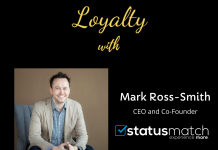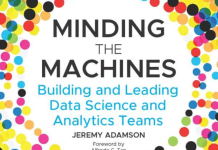
Airline loyalty breakage is growing discussion point for many frequent flyer programs
Len Llaguno – Founder and CEO of SnapShotML, firm providing a financial measurement for loyalty programs, about the challenges that loyalty programs face when trying to optimize the tradeoff between breakage and engagement.

He has spent nearly ten years helping many of the world’s largest loyalty programs manage program liabilities worth several billion dollars. Len works with finance and loyalty teams to address the challenge that breakage drives profit today, but hurts long-term engagement.
Let’s explore how Big Data can assist Loyalty and Finance teams with this challenge…
Big Data is a popular topic. How do you think being data-driven will benefit loyalty programs from a financial management perspective as we head into 2018?
- I think being data-driven will become even more important for loyalty program financial management in 2018. As an industry, we lack a credible financial measurement framework. A classic example is a question, “how do we manage the engagement/breakage trade-off?” That is, we know breakage drives profit today but hurts engagement and long-term profit. We need a framework to help us answer these types of questions.
- Financial measurement will become more important in 2018 as we see the effects of new accounting standards for loyalty programs (ASC 606 in the US and IFRS 15 elsewhere). Liabilities will likely increase, particularly in the US where the accounting changes are more significant.
- These changes don’t affect the underlying economics of programs, but it will likely increase the difficulty for programs to communicate this amidst all the noise. The discussion between Chief Financial Officers and Loyalty Managers won’t be helped without the smart use of data. Some may have an urge to devalue programs, so it will be important to clearly quantify program economics and the long-term profit that would be lost if the program was devalued.
Briefly describe the role big data and analytics plays in managing a loyalty program (strategy/financials etc)?
- Many companies are already doing all kinds of marketing analytics. They are using data and data science to better understand the wants and needs of their members to build a better customer experience. This use case will only continue to grow.
- This same rigour is not applied to financial use cases. Again, the struggle to resolve the breakage/engagement trade-off is a perfect example. Many companies are leaving a lot of long term profit and customer retention on the table because they aren’t optimizing this trade-off.
Loyalty programs always struggle to accurately estimate the cost of a point/mile, as well as their future breakage rates. With mileage expiration horizons often 2 or 3 years away, how accurate are these points cost and breakage estimates?
- I’m constantly surprised at how accurate we can get these estimates if the right methodology is used. The vast volumes of data, an abundance of computing horsepower and advances in machine learning make this possible. Many companies have not invested in this area, so there’s a lot of value for companies to upgrade their capabilities.
What are loyalty programs doing wrong, and what can they do in the future to improve the accuracy of these estimates?
- For finance folks, they should know that traditional methods for valuing loyalty program liabilities are not responsive enough because they are based on methods developed for the insurance industry decades ago. Loyalty is much more dynamic and fluid, requiring a more responsive approach.
- For marketing folks, they should know that these liabilities have massive financial footprints, which is why finance is so concerned with decreasing breakage. Lower breakage will drive material short term increases in costs and reductions in profits. These short-term costs are often warranted if there are offsetting long term benefits. Marketers need a credible financial measurement framework to quantify these costs and benefits. It’s very hard to get finance buy in without it.
What is the danger to companies and their loyalty programs if they get these estimates wrong?
- The risk is substantial for many programs because of the scale of the liabilities. Many programs have liabilities in the billions of dollars. Even a small 1% unexpected true up on a $1B liability will cost the program $10M dollars.
- We can also think about it from an opportunity cost perspective – how much profit is not realized because we haven’t optimized the breakage/engagement trade off? This could be material.
Companies have treasure troves of data on historical transactions, earning activity and past redemption behavior.
Many loyalty programs believe that the secret to leveraging Big Data is to look at this past behavior.
But are there risks to a company that only uses historical redemption behavior to try and predict future redemptions, for example?
- I understand this perspective. You’re absolutely right, historical data has its limitations. There’s no way around the fact that all models are flawed. It’s helpful to remember that all business people are tasks with the job of trying to make the best decision possible with the data available.
- So, it comes down to leveraging the data to make the smartest assumptions possible. My job is to extract every ounce of knowledge from data and combine that with the collective judgement of smart professionals to arrive at the best answer.
- In the end, I don’t think anyone is looking for 100% of the information before they make a decision. They just need 70% to 80%. In many cases, studying historical data (if done right), can get you there. It will certainly get you to a better place than not using the data at all.
Many loyalty program executives believe that their points-cost and breakage valuations are accurate. In fact, many programs update their breakage figures monthly, based on current redemption rates.
Are loyalty managers falling into a complacency trap, and forgetting to accurately forecast future changes in the breakage rate?
- There are definitely risks, but I understand that program leaders need to prioritize what’s most important. And to be honest, the thought of investing in more sophisticated financial analytics is probably not top of mind unless you’re a finance wonk.
- But I think a reframe of the situation is helpful to illustrate a huge opportunity. I see the program liability as a massively underutilized tool for program executives.
- All of those outstanding points are a huge incentive to drive desired behaviours. Most programs rejoice when we see a member with lots of points about to expire – it will get those points off the books at no cost! I think this is short-sighted.
- Instead, we could use those points to motivate a dormant member to come back. Yes, this will increase redemption costs, but will there be an offsetting increase in future revenue?
- The challenge is finding members where the upside is greater than the cost. I think this is a huge opportunity for program managers and a great reason for them to invest in financial analytics.























